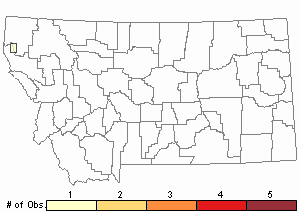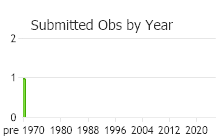View in other NatureServe Network Field Guides
NatureServe
Montana
Utah
Wyoming
Idaho
Wisconsin
British Columbia
South Carolina
Yukon
California
New York
A Oligotrichum Moss - Oligotrichum aligerum
General Description
Plants: Acrocarpous (Vitt 1981). Growing in upright clumps with shoots laxly-spaced or somewhat closer to each other, pale, olivaceous. Stems 20-30 mm in height, thin, unbranched or seldom branching from just beneath terminal reproductive organs (FNA 2007).
Leaves: Upright and near to the stem when dry, spreading more or less when damp, 3-5 mm in length, lance-shaped with ovate tendencies, the base partially enveloping the stem, grooved above, lamellate on both leaf faces; margins unbordered, somewhat sharply bent back and curved under narrowly (FNA 2007), or upright and curved inward a little (Lawton 1971), saw-toothed except for the proximal 1/4; costa extending to the apex and terminating in a short point (FNA 2007).
Leaf Cells: Dorsal lamellae robust and arising from the outer surface of the costa as well as 3-4 projecting from the lamina on each side of the costa, with a height of 1-3 cells, in profile the top (margin) of each lamella appearing saw-toothed; ventral lamellae 5-7 (FNA 2007) or as many as 12 (Lawton 1971), all arising from the costa, with a height of 5-9 cells, the margin appearing undulate to saw-toothed; laminae wide, 1 cell-layer thick, proximal cells short and quadrangular; medial laminal cells square with the angles curved, arranged in even, lengthwise series (FNA 2007).
Range Comments
Canada: BC; USA: WA and OR, e to MT; Mexico (FNA 2007). Known in Montana from Lincoln County (Elliott & Pipp, 2016).
Observations in Montana Natural Heritage Program Database
Number of Observations: 1
(Click on the following maps and charts to see full sized version)
Map Help and Descriptions
Relative Density

Recency


 (Observations spanning multiple months or years are excluded from time charts)
(Observations spanning multiple months or years are excluded from time charts)
Habitat
Humus and damp soil with clayey or sandy texture, on roadside slopes, and exposed roots from upended trees in areas influenced by a Pacific maritime climate (FNA 2007). Low and somewhat higher elevations, seldom reaching 4920 feet (Lawton 1971).
Reproductive Characteristics
Dioicous. Perigonial bracts widely egg-shaped and somewhat triangular, forming a prominent rosette; perichaetial bracts larger than the foliage leaves. Seta usually single, yellow with red tones, 30-40 mm in height, smooth, spiraled above when dry. Capsule 4-5 mm long, sometimes with 4 or more lengthwise crests (FNA 2007), slightly constricted below the opening when dry (Lawton 1971); the neck with a plethora of stomata; peristome double, the 32 teeth lightly-colored (FNA 2007) and with tiny papillae (Lawton 1971). Calyptra with few hairs (FNA 2007).
Stewardship Responsibility
References
- Literature Cited AboveLegend:
 View Online Publication
View Online Publication Elliott, J.C. and A.K. Pipp. 2018. A Checklist of Montana Mosses (1880-2018). Updated 3 January, 2020. Montana Natural Heritage Program, Helena, Montana. 73 pp.
Elliott, J.C. and A.K. Pipp. 2018. A Checklist of Montana Mosses (1880-2018). Updated 3 January, 2020. Montana Natural Heritage Program, Helena, Montana. 73 pp. Flora of North America Editorial Committee, eds. 2007. Flora of North America North of Mexico. Volume 27. Bryophytes: Mosses, Part 1. Oxford University Press, Inc., NY. xxi + 713 pp.
Flora of North America Editorial Committee, eds. 2007. Flora of North America North of Mexico. Volume 27. Bryophytes: Mosses, Part 1. Oxford University Press, Inc., NY. xxi + 713 pp. Lawton, E. 1971. Moss Flora of the Pacific Northwest. Hattori Botanical Laboratory. Japan: Yamabuki-cho, Shinjuku-ku, Tokyo. 362 pages plus appendices.
Lawton, E. 1971. Moss Flora of the Pacific Northwest. Hattori Botanical Laboratory. Japan: Yamabuki-cho, Shinjuku-ku, Tokyo. 362 pages plus appendices. Vitt, D. J. Marsh, and R. Bovey. 1988. Mosses, Lichens & Ferns of Northwest North America. Seattle, WA: University of Washington Press. 296 p.
Vitt, D. J. Marsh, and R. Bovey. 1988. Mosses, Lichens & Ferns of Northwest North America. Seattle, WA: University of Washington Press. 296 p.
- Additional ReferencesLegend:
 View Online Publication
View Online Publication
Do you know of a citation we're missing? Elliot, J. C. 1993. Second checklist of Montana mosses. Unpublished report. U.S. Forest Service, Region 1. Missoula, MT. 45 pp.
Elliot, J. C. 1993. Second checklist of Montana mosses. Unpublished report. U.S. Forest Service, Region 1. Missoula, MT. 45 pp. Lawton, E. 1971. Keys for the Identification of the Mosses on the Pacific Northwest. Reprinted from 'Moss Flora of the Pacific Northwest'. Published as Supplement No. 2 of the Journal of the Hattori Botanical Laboratory. Nichinan, Miyazaki, Japan. 66 pp.
Lawton, E. 1971. Keys for the Identification of the Mosses on the Pacific Northwest. Reprinted from 'Moss Flora of the Pacific Northwest'. Published as Supplement No. 2 of the Journal of the Hattori Botanical Laboratory. Nichinan, Miyazaki, Japan. 66 pp.
- Web Search Engines for Articles on "A Oligotrichum Moss"





